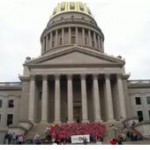Widgetized Section
Go to Admin » Appearance » Widgets » and move Gabfire Widget: Social into that MastheadOverlay zone
National Service: America’s Tool For Getting Things Done
The views expressed are those of the author and do not necessarily reflect the views of ASPA as an organization.
By Cassandra Argo
March 24, 2015

West Virginia’s national service members gathering on the front steps of the State Capitol. Photo by Cassandra L. Argo.
The Corporation for National & Community Service (CNCS) website states that “National Service is a cost-effective solution that taps the power of citizens to get things done.” Since 1994, 900,000 people have served 1.2 billion hours of national service. But what is national service and how did it become the nation’s leading, cost-effective solution to the plight of low-income communities across America?
The idea of national service has been ingrained in the hearts of citizens since America’s earliest days. However, the idea of national service found its strength with the creation of the Civilian Conservation Corps (CCC) in the 1930s. With 4 million young adults answering President Franklin D. Roosevelt’s call to join the CCC, the national service movement has grown and adapted to the changing needs of communities all across the country. The first major adaptation came with President John F. Kennedy’s vision of a national service corps similar to the newly created Peace Corps that would “help provide urgently needed services in urban and rural poverty areas.”
President Kennedy’s dream became a reality as part of President Lyndon B. Johnson’s Economic Opportunity Act of 1964 when the first class of Volunteers in Service to America (VISTA) was sworn into service in January 1965 to focus on fighting poverty. VISTA joined with the Peace Corps and Senior Service programs in the 1970s to create the ACTION Agency. President George H.W. Bush created the Commission on National and Community Service during his presidency which led to the next major change to national service during the Clinton administration.
President Bill Clinton expanded upon his predecessors’ national service and volunteerism movements in 1993 by combining the ACTION agency and the Commission on National and Community Service into the Corporation for National and Community Service (CNCS). CNCS was tasked with managing three programs: Senior Corps, Learn and Serve America and AmeriCorps. AmeriCorps engages over 75,000 Americans annually in service to communities across the country within its three main branches: AmeriCorps State and National, AmeriCorps VISTA, and AmeriCorps National Civilian Community Corps (NCCC).
AmeriCorps NCCC is a 10 month, team based, residential program for young adults aged 18-24. NCCC members are placed in teams which are then stationed at one of the following regional campuses: Vinton, Iowa; Baltimore, Maryland; Jackson, Mississippi; Sacramento, California; or Denver, Colorado. More than 1,200 NCCC members are deployed to various projects such as trail building and disaster relief efforts throughout their campus’ regional service area each year.
While NCCC members are mobile and multi-focused, AmeriCorps VISTA members are placed in community organizations with a singular focus. VISTA members serve full time in the fight against poverty. VISTA members fight poverty in local communities by building their host site’s capacity to serve individuals and families living in poverty through volunteer recruitment, resource development and curriculum creation.
The AmeriCorps State program is complementary to VISTA. State members serve 1700 hours in direct service to local communities with a focus on one or more of the AmeriCorps state program’s six focus areas: economic opportunity, veterans and military families, healthy futures, education, environmental stewardship and disaster services. AmeriCorps state members strengthen communities through a variety of activities such as training volunteers, teaching nutrition classes and tutoring at-risk youth.
AmeriCorps members, regardless of their branch of service, turn limited resources of local communities into strong and effective assets that meet the most urgent needs within their community. Members come from all walks of life using their unique experience and skills to confront the issues and needs that are prevalent in low-income communities. In addition to the empowering opportunity to get things done in resource-deprived communities, members are provided a modest living stipend, given the option to receive an education award and encouraged to make professional connections and gain hands-on professional skills.
CNCS emphasizes professional development as a means to strengthen employability, encourage continued civic engagement and empower citizens to get things done in their communities long after their service term has ended. With this long-term citizen engagement goal, CNCS administers a $1billion annual budget to place more than 75,000 national service members in 15,000 locations annually. According to the AmeriCorps Fact Sheet, these 75,000 members, in turn, mobilized 4 million volunteers and leveraged $480 million in additional cash or in-kind donations in the fight to get things done for their communities.
If you would like to learn more about the Corporation for National & Community Service, the National Service options available, or to join AmeriCorps, please visit the Corporation’s website at www.nationalservice.gov or follow them on Facebook and Twitter. Together we can strengthen communities through national service!
Author: Cassandra L. Argo is a native Ohioan living in West Virginia to realize her dream of serving as an AmeriCorps Program Officer with Volunteer West Virginia, the state’s commission for national & community service. Cassandra holds a BASW from Asbury University and is an alumna of both the AmeriCorps State and AmeriCorps VISTA programs. Cassandra can be reached at [email protected].


Follow Us!